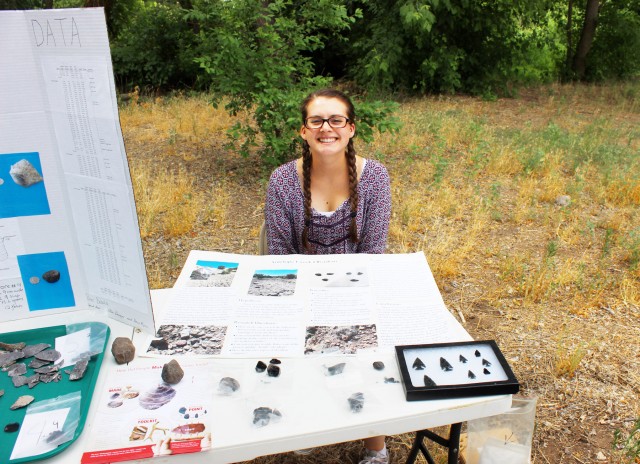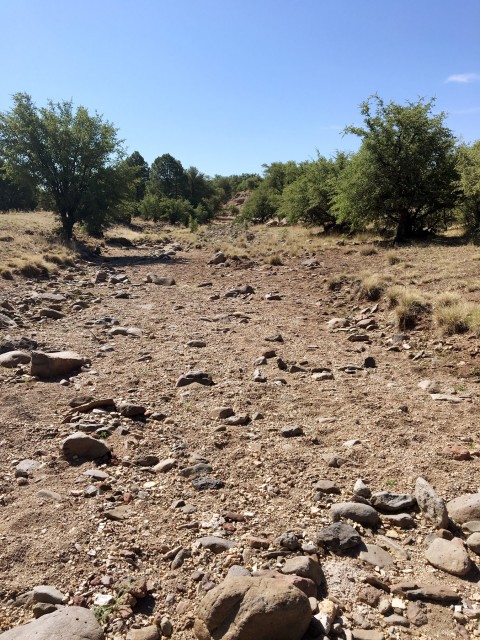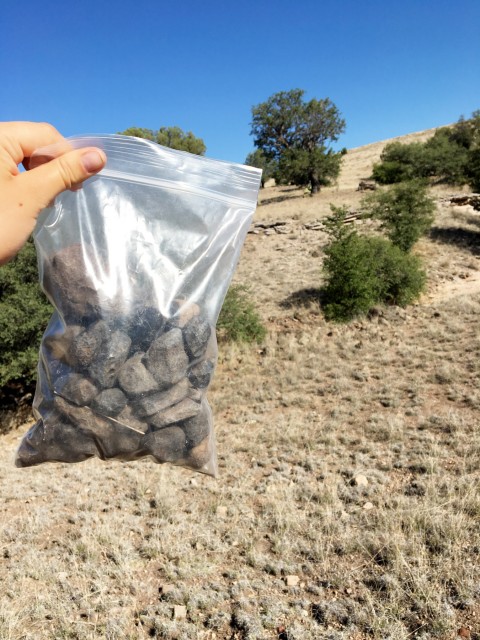- Home
- >
- Preservation Archaeology Blog
- >
- Antelope Creek Obsidian
Kaitlyn Cometa, University of Delaware
(July 12, 2016)—What is the first thing you think of when you hear someone refer to the obsidian at a specific source as “bomb” obsidian? Probably that you don’t want to be near it when it blows up. I however, was drawn to the idea of the “bomb” obsidian and my head flooded with questions about it. Where does it come from? Why does it explode when you try to drive a flake from the core?
Allen Denoyer, our experimental archaeologist and expert flintknapper, introduced me to this bad obsidian the very first time I flintknapped. He said something along the lines of “this is probably that bomb stuff, here watch it explode” much too casually. He proceeded to tell us that this poor quality obsidian comes from one source off of Mule Creek called Antelope Creek, and for many years everyone believed that all of the obsidian in that area was this bad “bomb” obsidian.
Recently, however, Steven Shackley discovered that there are good-quality obsidian nodules at Antelope Creek—unfortunately, the good and the bad are all mixed together. The strange thing about the obsidian at this source is that chemically it is all the same, meaning that is came from one single volcanic event. Yet something, potentially more water within the nodules, is causing the bad obsidian to deteriorate faster, resulting in little silica bombs.
|
|
This is where my interest was piqued. How might you tell the difference? Do you just have to take a chance and hope shards of razor sharp obsidian don’t go flying in all directions?
My interest in this mysterious obsidian found at Antelope Creek led me to perform an experiment for my Archaeology Fair project. With help from Allen Denoyer and Stacy Ryan, I planned my experiment, which began with retrieving the obsidian. During the second day of experimental archaeology excursions with Allen, we trekked up to Antelope Creek, where I collected 148 nodules of obsidian. From the beginning, I had an inkling about which was the poor-quality obsidian and which was the good based on the appearance of the cortex, or skin.
Upon returning home to our quirky camp in Cliff, I went to work. I chose 15 nodules of the two types of obsidian I was seeing. One type had a brown, matte cortex while the other had a shinier black cortex. I weighed and measured all 30 nodules that I chose and placed them into individual bags.
Next came two lovely evenings of flintknapping with Allen and Stacy. I began with what I believed to be the good obsidian, the nodules with the brown matte skin. Much to my excitement, the first evening of flintknapping Group A obsidian was a success. I was able to drive useable flakes from each nodule in rather good time. This meant I was half-right so far: I could tell which nodules were effective cores.
The only thing left was to test the bad obsidian, Group B, to see how bad it really was. This is where the title of “bomb” obsidian made me nervous. My second evening consisted of cracking open stubborn and unpredictable obsidian nodules. This process took nearly twice as long as the evening before, resulting in a swollen knot on my thigh and a whole lot of frustration. The little bombs lived up to their name; after around 10 to 15 minutes of whacking potential platforms, little tiny flakes were flying. Several were nearly impossible to crack open, resulting in miniscule unusable flakes. Some were bad enough that I needed help from Allen to break them open. He had no better luck and also ended up with a lap-full of tiny shards. Out of my sample of 15, only 4 nodules produced any useable flakes, and even then they were hardly usable.
After escaping my experiment relatively unscathed, I realized I had proven my hypothesis correct! There is in fact a visible difference between the good-quality obsidian and poor-quality obsidian found in the Antelope Creek area. The majority of the black shiny nodules (Group B) did not produce quality flakes. I did notice during my experiment that not all Group A obsidian was excellent quality. The smaller, rounder nodules are still difficult to drive good-quality, usable flakes from, and would only be good for small points. The larger nodules of the Group A obsidian do produce large, good-quality flakes for tool making. When looking for obsidian in the Antelope Creek area, the best-quality obsidian is the larger nodules with good striking platforms and a matte brown cortex; avoid the shiny black nodules.
My experiment was a success, and I was proud to present my findings to the many people who attended our Archaeology Fair. Although I know that lithic (stone tool and manufacturing debris) analysis doesn’t quite get the crowds a’roaring, I really enjoyed putting this experiment together and following through to get quality results and data. It also really solidified my love for lithics!

Explore the News
Related to This
-
Project Hands-On Archaeology

